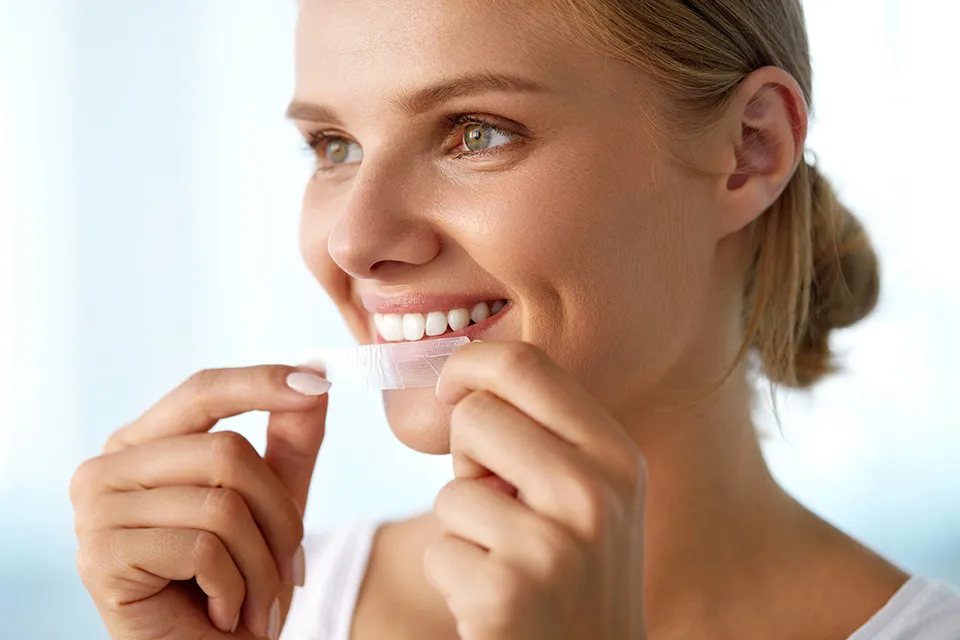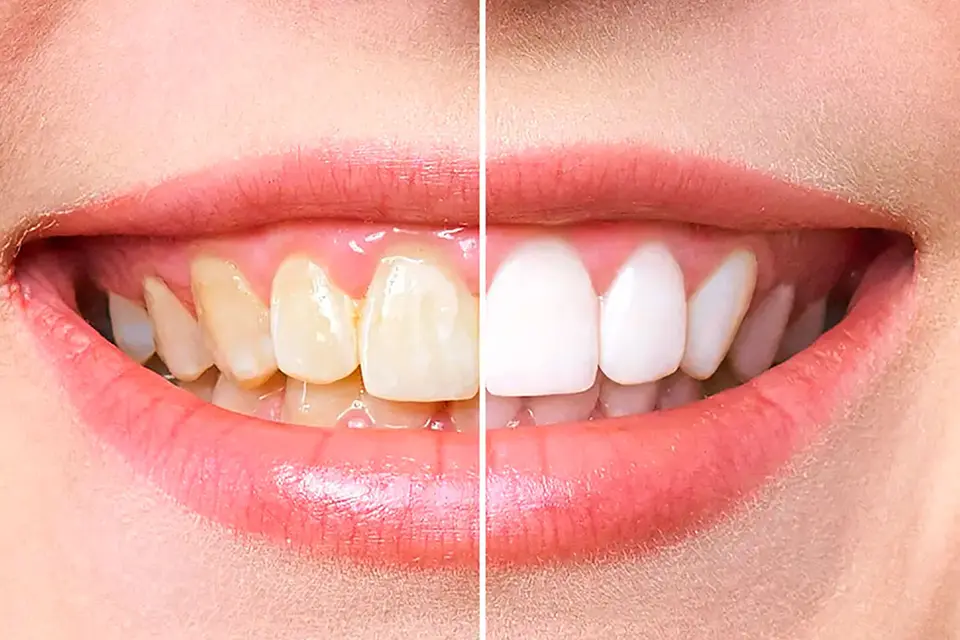Teeth whitening has become popular in cosmetic dentistry as individuals strive for a more radiant smile. As a whiter smile is frequently associated with health, youth, and aesthetic appeal, this surge in interest stems from the desire to enhance one’s appearance. Achieving an impeccable smile has become an increasingly attainable goal due to the wide range of products available and advancements in dental technology.
What Are the Best Teeth Whitening Methods?
There are a variety of techniques, each with advantages and disadvantages. When deciding on the best approach to teeth whitening, consider factors such as effectiveness, cost, convenience, and potential side effects.
At-Home Teeth Whitening
At-home teeth whitening is a convenient and affordable solution to brighten your smile. It includes products like whitening strips, gels, and trays that you can use at home. These products are often less expensive than professional treatments, but they may take longer to show results and be less effective on deeper stains.
Professional Teeth Whitening
Professional teeth whitening by a dental professional requires more vital whitening agents and specialized methods. This method usually provides faster and more noticeable results than at-home treatments. However, it is usually more expensive and necessitates appointments at a dental clinic.
Laser Teeth Whitening
Laser teeth whitening is a cutting-edge treatment that employs laser technology to increase the effectiveness of whitening agents. This approach provides quick results and can significantly lighten teeth in a single session. However, it is typically the most expensive option and may only be suitable for some.
Whitening Strips
Whitening strips are thin, flexible strips coated in whitening gel. They are easy to apply, relatively affordable, and widely available, making them a popular choice for at-home whitening. However, their effectiveness may differ, and they may only cover some teeth evenly.
Whitening Toothpaste
Whitening toothpaste is designed to eliminate surface stains while mildly whitening teeth over time. Although these toothpastes are inexpensive and convenient for gradual whitening, they may not produce dramatic results and are less effective on deep stains.
Natural Teeth Whitening Remedies
Natural teeth whitening remedies include methods like oil pulling or using baking soda. These approaches may be gentler on the teeth and gums, but their effectiveness varies greatly and is often less pronounced than commercial products.
LED Teeth Whitening
LED teeth whitening, like laser whitening, utilizes light technology to accelerate the process. It is often used in combination with at-home kits and can enhance the results of the whitening treatment.
What Are the Best Products to Whiten Your Teeth?
Numerous teeth whitening products are available on the market, making choosing the most effective one difficult. It is critical to look for products that balance safety and effectiveness and seek advice from a dental professional.
Whitening Kits
Whitening kits typically include whitening gel and a tray or strips. These kits provide a more comprehensive solution for teeth whitening and are available in over-the-counter and professional-grade options. Although they have the potential to produce significant outcomes, their consistent application may be necessary.
Whitening Gels
Whitening gels contain peroxides, which help remove deep stains and whiten teeth. They can be used alone or with trays and vary in strength. Higher concentrations produce faster results, but they may raise the risk of tooth sensitivity.
Teeth Whitening Pens
Teeth whitening pens are portable and easy to use, allowing for precise application of whitening gel. They are excellent for touch-ups and targeting specific areas but may not be as successful for overall whitening as other procedures.
Charcoal Whitening Products
Activated charcoal is well-known for its ability to absorb stains and toxins, making it an increasingly popular ingredient in natural whitening solutions. However, its abrasive nature may cause enamel damage over time, and its effectiveness in whitening teeth is still debated.
Peroxide-Based Whiteners
Products containing hydrogen or carbamide peroxide are among the most effective for whitening teeth. Although they should be used carefully to avoid gum irritation and tooth sensitivity, they can produce noticeable results.
Non-Peroxide Whiteners
Whiteners that do not contain peroxide are safer for individuals with sensitive teeth or gums. Although milder on the teeth than peroxide-based whiteners, these products may contain sodium bicarbonate or certain enzymes and may be less effective.
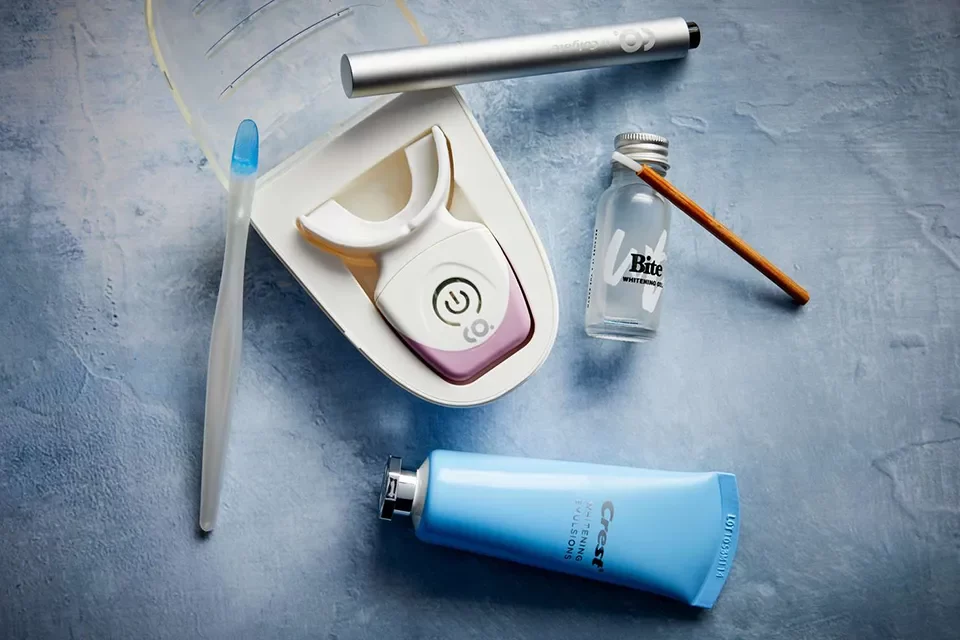
What Ingredients Are Used for Whitening Teeth?
The active ingredients in teeth whitening products, which remove stains and lighten teeth in various ways, are primarily responsible for their effectiveness.
Hydrogen Peroxide
Hydrogen peroxide is a powerful bleaching agent commonly used in teeth whitening products. It is effective in removing deep stains and can provide rapid results. However, some people may experience sensitivity, particularly at higher concentrations.
Carbamide Peroxide
As an alternative to hydrogen peroxide, carbamide peroxide is less aggressive. It gradually releases hydrogen peroxide, making it a gentler option for teeth whitening. It is frequently used in both home whitening products and professional procedures.
Baking Soda
Baking soda is a mild abrasive that can remove surface stains on teeth. It is frequently found in whitening toothpastes and can be used as a natural teeth whitener. Although it may not be as effective as alternative methods, its whitening effect is limited to surface stains.
Activated Charcoal
Activated charcoal is often used in natural whitening products due to its ability to absorb stains and toxins. However, the long-term effects of activated charcoal on tooth enamel are still being studied, and its abrasive nature may cause enamel wear over time.
Coconut Oil
Coconut oil is used in oil pulling, a traditional oral hygiene practice. It is believed to help remove bacteria and whiten teeth, although scientific evidence supporting its effectiveness for teeth whitening is limited.
Natural Ingredients
Natural ingredients such as turmeric, coconut oil, and fruit enzymes are gaining popularity due to their purported whitening effects. These ingredients are often found in natural or homemade whitening remedies. Although they may present a more harmless alternative to chemical whiteners, further research is necessary to confirm their effectiveness.
Is Teeth Whitening a Safe Procedure?
This treatment is generally safe when performed correctly. However, following proper usage instructions and being aware of potential side effects is critical. Overuse or misuse of whitening treatments can result in tooth sensitivity, gum irritation, and, in rare cases, enamel damage.
How to Reduce Sensitivity After Teeth Whitening?
Consider using a fluoride mouthwash or toothpaste to remineralize the teeth and reduce post-whitening sensitivity. Additionally, avoid consuming foods and beverages that are extremely hot or cold. It’s also critical to follow the instructions on the whitening product and stay within the recommended.
Can Teeth Whitening Damage Tooth Enamel
These products are unlikely to cause enamel damage when used as directed. However, excessive or improper use of these products may increase tooth sensitivity and enamel erosion. It’s essential to choose reputable products and follow the instructions carefully.
How Can I Protect My Gums When Teeth Whitening?
To protect your gums during this treatment, avoid applying whitening agents directly to the gums, and consider using custom-fitted trays to prevent the gel from leaking onto the gums. When using these strips or pens, ensure you only apply the product to the teeth and avoid contact with the gums.
Are There FDA-Approved Teeth Whitening Methods?
The U.S. Food and Drug Administration (FDA) regulates some oral care products but does not specifically approve this treatment. Nonetheless, products manufactured by reputable companies and adhering to safety standards are essential. Consult a dental professional for advice on safe and efficient whitening products.
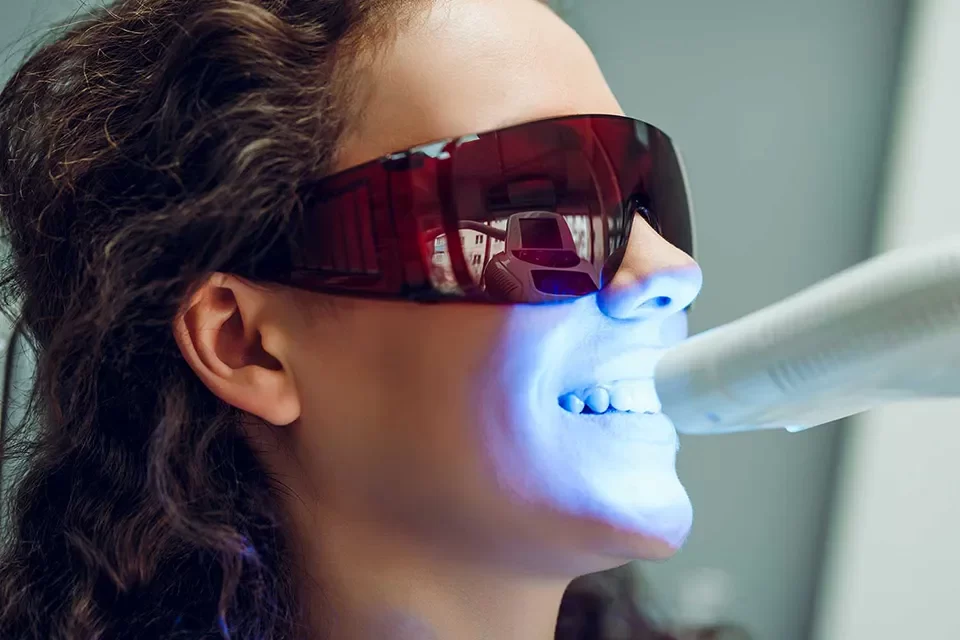
What Are the Benefits of Teeth Whitening?
This treatment offers several benefits beyond just a brighter smile. In addition to improving your dental health, it can boost your confidence and overall appearance.
Cosmetic Benefits (Whiter, Brighter Smile)
The most obvious benefit is the improvement in the appearance of your teeth. A brighter smile can enhance a youthful appearance, improving confidence and facial features.
Psychological Impact (Confidence, Self-esteem)
A brighter grin can boost your confidence and self-esteem, so improving your social and professional interactions. Many people find that after teeth whitening, they are more willing to smile and interact with others, which leads to better relationships and opportunities.
Effect on Oral Health
While this treatment may not directly enhance oral health, the desire for a brighter smile can inspire individuals to practice better dental hygiene. People who invest in this treatment are more likely to brush, floss, and attend frequent dental check-ups to preserve their results, contributing to better oral health.
Aftercare Tips for Teeth Whitening
To maintain treatment results, follow some aftercare guidelines. By adhering to these practices, you can maximize the longevity of the whitening process and maintain a radiant smile.
Lifestyle Changes to Prolong Whitening Effects
Consider adopting a lifestyle that reduces exposure to staining agents to prolong the effects of the treatment. This involves avoiding or minimizing the consumption of foods and beverages that might stain teeth, such as coffee, tea, red wine, and dark fruits and berries. Quitting smoking and using tobacco products is also critical, as they contribute significantly to tooth staining.
How to Retain the Results of Teeth Whitening?
Consider using at-home whitening products regularly to maintain the effects of your treatment. Using whitening toothpaste can also help you maintain your results by removing surface stains. Regular dental check-ups and cleanings are also necessary to keep your teeth healthy and bright.
Diet and Lifestyle Changes for Whiter Teeth
Adopting a diet rich in fruits, vegetables, and dairy products can contribute to healthier and whiter teeth. These foods can naturally clean your teeth while providing the necessary nutrients for dental health. Furthermore, you can avoid tooth decay and staining by limiting the consumption of acidic and sugary foods and beverages.
Does Oral Hygiene Make Teeth Whiter?
In order to maintain the results, proper oral hygiene is vital. Regular flossing and brushing can stop the formation of new stains and preserve the brilliance of your teeth. Dentists recommend using a toothbrush with soft bristles and non-abrasive toothpaste to avoid damaging the tooth enamel.
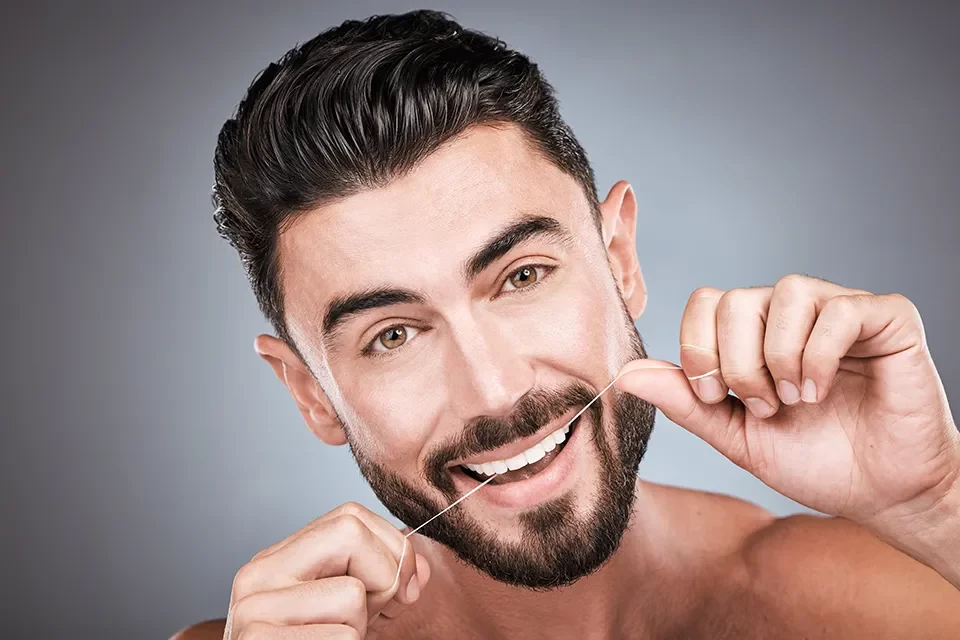
Teeth Whitening for Different Teeth Types
Different types of teeth, such as yellow or discoloured ones, respond differently to whitening treatments. Understanding your tooth discoloration type will help you choose the most effective whitening treatment.
How to Whiten Yellow Teeth
Yellow teeth, often caused by external factors like diet, smoking, or aging, usually respond well to whitening treatments. Both at-home and professional treatments can effectively lighten yellow teeth. In order to prevent a recurrence, it is essential to address the underlying causes of the discoloration.
How to Whiten Discoloured Teeth?
Discoloured teeth have numerous potential causes, including genetics, certain medications, trauma, and medical conditions. Understanding the cause of the discoloration is critical in choosing the best whitening treatment. Some types of discoloration, such as those caused by tetracycline or fluorosis, may not respond well to traditional whitening treatments and may necessitate additional cosmetic solutions such as veneers or bonding.
Teeth Whitening Before and After
Evaluating before and after results can give you an idea of the potential effectiveness of different whitening methods and help set realistic expectations. Witness this transformation through before-and-after pictures of real customers!
Longevity of Whitening Effects
The duration of whitening effects varies based on the method used, the initial level of staining, and your lifestyle habits. Professional treatments often provide more long-term outcomes than at-home approaches. By avoiding staining agents and practicing proper oral hygiene, it is possible to prolong the effectiveness of the whitening process.
Real Customer Results and Testimonials
One of the most convincing aspects of this treatment is seeing the real-world results and hearing firsthand experiences from those who have undergone the treatment. At White Pearl Dental clinic in Vaughan, Ontario, we take pride in showcasing the transformations achieved through our services. In this section, we will share before-and-after photos of clients to give you a clear understanding of the effectiveness of our treatments.
These customer images not only serve as evidence of the dramatic changes that can be achieved with teeth whitening but also help set realistic expectations for potential clients.
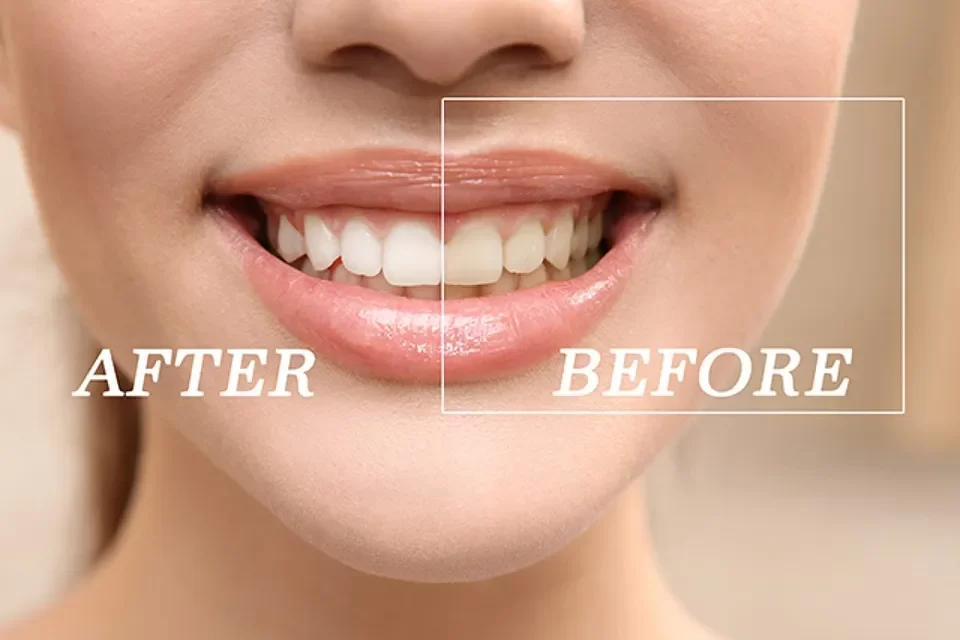
Frequently Asked Questions
How Long Does Teeth Whitening Last?
Several factors can significantly affect the durability of teeth whitening results, including the method employed, the individual’s dietary habits, oral hygiene practices, and the natural colour of the teeth. Generally, professional teeth whitening can last from six months to two years. Nevertheless, you can prolong the effects with proper oral hygiene and avoiding staining substances such as tobacco, coffee, tea, and red wine. Touch-up treatments can also help maintain the whiteness.
Can Everyone Whiten Their Teeth?
While most people can whiten their teeth, there are some exceptions. Dental Professionals do not recommend this treatment for children under 16, pregnant or nursing women, or those with sensitive teeth, gum disease, worn enamel, cavities, or exposed roots. Those with restorations like crowns, veneers, or fillings should note that these will not whiten like natural teeth. It is critical to visit a dentist to determine whether you are a good candidate for teeth whitening.
Are Whitening Strips Bad for Your Teeth?
Whitening strips are generally safe when used as indicated. However, overuse or misuse can cause dental sensitivity and gum irritation. It is critical to adhere to the product instructions and stay within the recommended duration or frequency. Before using these strips, individuals with sensitive teeth should consult their dentist or utilize products explicitly formulated for sensitivity.
Should I Brush My Teeth After and Before Using Whitening Strips?
Dentists recommend brushing your teeth before applying whitening strips to ensure the whitening agent is in direct contact with your teeth. Brushing right before using the strips, however, may irritate your gums. It is essential to wait at least 30 minutes after using strips to allow your enamel to re-harden, especially if you have tooth sensitivity.
Do Banana Peels Whiten Teeth?
The idea that banana peels can whiten teeth is more myth than fact. While banana peels are high in potassium, magnesium, and manganese, which are beneficial to overall dental health, there is no scientific evidence that rubbing a banana peel on your teeth whitens them. It is advisable to adhere to proven methods to achieve optimal results with whitening.
Does Fluoride Whiten Teeth?
Fluoride is well known for strengthening tooth enamel and preventing cavities but not for tooth whitening. While some whitening toothpastes contain fluoride, other ingredients, like mild abrasives or chemical agents, contribute to the whitening effect.
How Long After Teeth Whitening Can I Eat Normally?
After this treatment, particularly professional procedures, your teeth may be more susceptible to discoloration. You should avoid eating or drinking anything that will discolour your teeth for at least 48 hours. This includes foods and beverages such as coffee, tea, red wine, and dark-coloured fruits and sauces. After this period, you can resume your regular diet, although keeping proper oral hygiene and avoiding stain-causing foods can help prolong the whitening results.
How to Whiten Teeth with Braces?
Whitening teeth with braces can be challenging, as traditional methods might not be effective or advisable. Practicing good dental hygiene when wearing braces is best to avoid discoloration. Although some options, such as mouthwash and whitening toothpaste, can be utilized, they will only affect the surfaces of the teeth that are exposed. Waiting until the braces are removed is advisable for a more uniform whitening. Once the braces are off, you can explore various whitening treatments for more comprehensive results. Always consult your orthodontist or dentist before starting any whitening procedure while wearing braces.
Final Thoughts
In conclusion, teeth whitening is an effective and risk-free method for improving the appearance of one’s smile and boosting self-esteem. With various methods and products available, there’s a solution to fit every need and budget. You can choose the proper whitening treatment by considering your circumstances and consulting a dental professional. Following proper aftercare and maintenance techniques will allow you to maintain a brighter smile for years. White Pearl Dental in Vaughan, Ontario, is here to assist you in achieving the radiant smile you desire.

